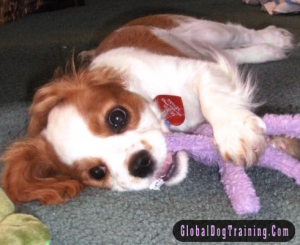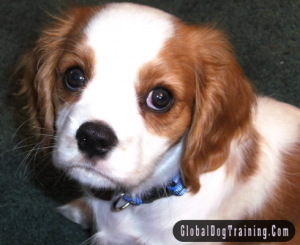
Adolescent puppies may experience a decline in confidence if they are not continually exposed to new situations in a positive and controlled way
By now, your new puppy is adjusting well to his new family. You probably already have started him in a good, positive puppy training class. After all, you have heard time and time again, that you should be socializing your puppy.
Puppy socialization is a process in which you gradually introduce your puppy to a variety of people, places and things in the early stages of their lives. The opportunity for making the best impact on your puppy’s socialization is between 3 weeks and 4 months of age and continues until your puppy is about 6 months old. However, puppies go through various “fear periods” during the first 18 months of their lives, so do not stop an active socializing program once your puppy is 6 months old. During a puppy’s adolescent period (6 months thru 18 months) puppies can have a decline in confidence if they are not continually exposed to new situations in a positive and controlled way.
No Worries One of the most important things you can teach your puppy is to not worry. If you would like your puppy to become a great family dog who is not afraid of people, thunderstorms, loud noises, or unusual environments, then now is the time when you have the most influence over your puppy’s psyche.
Behavioral problems in dogs often develop from a lack of confidence. Instead of trying to fix a problem such as fear of fireworks or strangers, work hard on preventing them in the first place. You can take control and implement a proactive approach to your puppy’s development. This is where my No Worries training program comes into play.

Behavioral problems in dogs often develop from a lack of confidence; genetics aside, being proactive can go a long way towards prevention
Today, I want to talk about using the No Worries theory and how you can teach your puppy not to worry about thunderstorms. Thunder phobia in dogs is one of the hardest behavioral issues to treat in dogs, particularly if you live in a place where storms are frequent. Unfortunately, we cannot tell the storm, “Okay, that’s enough, not so loud” and control the intensity like we can with a lot of other behavioral problems. A thunder-phobic dog is continually being pushed past his comfort zone and threshold, making it a very complex situation to manage and treat.
In order to help buffer any future storm phobias, now is the time to develop the no worries attitude with storms. You are building habits and happy emotional responses to things (storms in this lesson), so it takes a lot of repetition to get our famous Pavlov response working.
Exercise #1 Get some high-value treat rewards. High-value is something your dog goes crazy over, I usually start by looking for meat products, such as cooked beef, salmon or lean pork. You want to make a real impact here, instead of using a regular dog biscuit or dog food.
Find various recorded storm sounds. You can purchase thunderstorm CDs, or use my favorite these days, YouTube. One important aspect here is to make sure you use different tracks, so it’s different at each lesson.
Turn the storm recording on with the volume very, very low. You do not want you to scare your puppy. Be ready. As soon as you hear a little rumble, toss your dog a tiny piece of treat. Repeat with the next rumble. Repeat this training lesson as often as you can think about it, daily would be wonderful. Try changing the rooms you practice in and do not forget to change that storm track! You do not always have to be sitting down either to do it. Remember, you want your dog to think this is normal.
Exercise #2-The Real Deal Ok, the real storm (or hopefully just a little rain and rumble) is here. Just like in your previous exercises, we are conditioning your dog that the rumbles and booms of thunder predict good things. Really, really, good things. Each rumble….toss a treat. Just like before. The difference is, you won’t be able to predict how loud those booms are going to be. So, if it’s pretty loud bomb, toss a jackpot. Treat, treat, treat. Wow!
What if the storm happens at 3 am? You guessed it; grab the treats or peanut butter jar, and give a treat or lick after each rumble. I highly recommend watching the weather stations to know when those storms are going to happen. Being prepared can pay off. Believe me, doing this at 3 am a few times is worth it. If your dog develops thunder phobia, you WILL be up at 3 am for storms.
Congratulations on your new puppy, and as the saying goes, an ounce of prevention is worth a pound of cure. Do you have a dog who already has storm phobia? Register for my thunder phobia workshop.
For more articles by Tonya Wilhelm visit: https://www.raisingyourpetsnaturally.com
